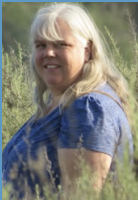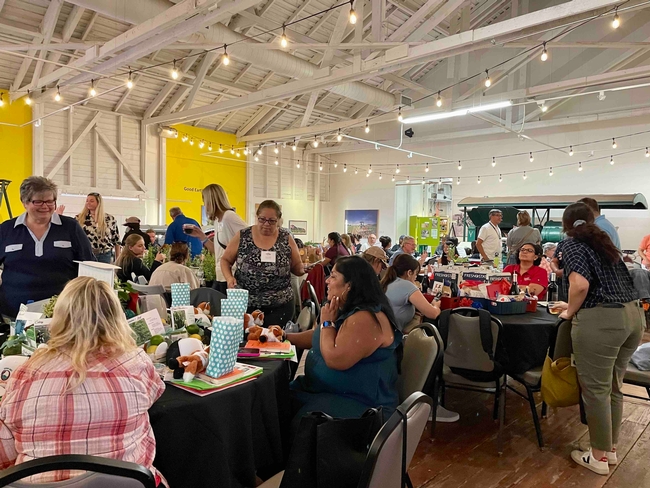- Author: Margaret J O'Neill
This month's spotlight is on UCCE San Bernardino County Master Gardener Donna Palmer. She has been a Master Gardener (MG) for a few years, joining during our first virtual class in 2021. She is a natural teacher and has taken on the role of being a MG like she had been doing it her whole life. She has done many talks for the community, and was a great support when we were in our initial stages of doing online talks, taking on the cohost role, and teaching us the fundamentals of what a good cohost was! She has taken this skill she has as a presenter and cohost on to help train her fellow MGs in that role and it is so appreciated! Be on the lookout for Donna giving talks in 2023 (they are great!) and also check out her articles in the Chino Champion on gardening as well. You will learn more from Donna below about her gardening passions, and I hope you too will feel excited about gardening all over again when you read Donna's thoughts from the garden.
-Maggie O'Neill, UCCE San Bernardino County Master Gardener Coordinator
Why did you decide to be a MG?
I've long wanted to become a member of this community of gardeners and garden educators but was too shy to actually do it. When classes went online during lockdown, my husband suggested I use the opportunity to achieve my goal. Now I can't believe I waited so long!
What are your gardening passions?
Absolutely everything! I love a garden, learning about plants and plant families, trying something new in my garden beds, tracking growth and experimenting with techniques, harvesting and cooking from the garden, photographing the garden, teaching about gardens, reading about gardens, visiting gardens or nurseries or farms…. You get the idea. If I had to choose two of my very favorite things they would be teaching basic gardening and practicing plant propagation. There's nothing like watching a student discover the sights, textures, and smells of a garden. Witnessing a new gardener relish a sun kissed tomato or devour a fresh crunchy green almost brings me to tears. And I love populating a new area of the garden with the progeny of my own plants.
What do you think gardening gives back to our community and why do you think it's important for overall community health?
What doesn't a garden give back? The solitary gardener gains a nutritious harvest while building soil, promoting neighborhood habitat, supporting pollinators, beautifying a site, and enriching individual well being. Not to mention achieving a sense of accomplishment with every bloom or harvest. And I've never met a gardener who didn't want to share a harvest or favorite seed. Something about plant stewardship nurtures people and creates community. Gardening within a group does all of this on a larger scale. Gardens beckon us in. They invite us to become aware and participate. They prompt us to share and to nourish one another.
Do you have any tips for the community about conserving water in the drought?
I'm learning to garden in a drought just like every other gardener. Drip irrigation, mulch, and Waterwise plants are becoming my best gardening friends.
What is a tidbit or two you've learned as a MG that the public reading our newsletter could gain from?
Nurturing a plant to harvest is a skill. It's ok to experiment and fail and try again. Gardens are hard work for all of us. The most experienced gardeners earned their gardens one plant at a time.
What advice would you give someone considering becoming a UCCE MG?
Do it! The community of Master Gardeners is welcoming, supportive, exciting, and fun. You and your new friends will find opportunities to learn, grow, and make a difference.
- Author: Deborah Schnur
I couldn't believe it when I heard that COMPOST2023, billed as “the world's largest composting event”, was going to be held in Ontario, California in January. What were the odds that a composting enthusiast such as myself would be so close to the action? I'm so glad I was able to attend as a volunteer! This year's theme was “Capturing Carbon Renewing Soil”, emphasizing the importance of composting in reducing carbon emissions and enhancing soil health.
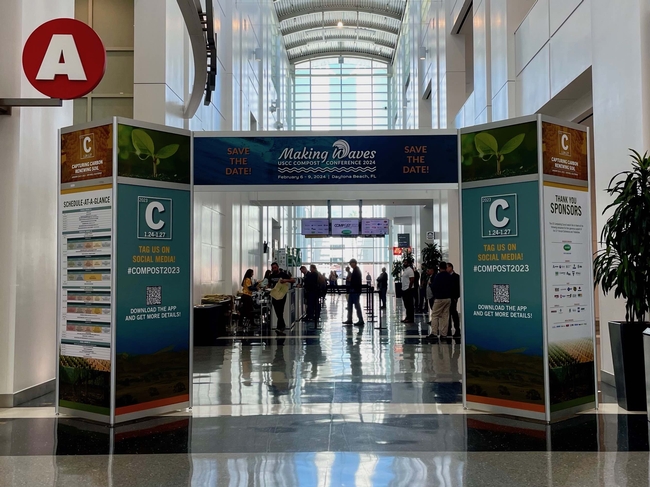
COMPOST2023 ran from Monday, January 23rd to Friday, January 27th, starting with two days of pre-conference activities. On the first day, I attended the Cultivating Community Composting Forum at the Ontario Convention Center. The second day was a Field Day with bus tours of local composting sites. I attended conference sessions at the Convention Center on Wednesday and Thursday and volunteered for Demo Day at One Stop Landscape Supply on Friday. It was a lot to absorb in such a short time.
The Institute for Local Self-Reliance (ILSR) coordinated the Cultivating Community Composting Forum and related Field Day activities. ISLR's Composting for Community Initiative works to advance “local composting to create jobs, enhance soils, protect the climate, and reduce waste through advocacy, training, research, demonstration sites, and coalition building”. The goals of the forum were to share best practices and build support for small-scale, community-based composting.
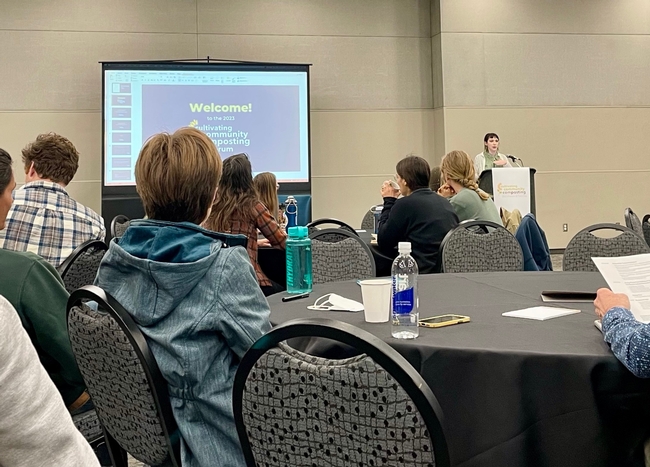
After a short break, the forum attendees reconvened for two peer-to-peer chat sessions on topics including scaling up, business and mission planning, funding and financing, and communications. I attended the sessions on community building and composting methods and best practices. These chats gave me the opportunity to share experiences with composters from across the country–from Peels & Wheels Composting in New Haven, Connecticut to ReMark Composting Solutions in Detroit to Hart's Worm Farm in Irvine.
The afternoon agenda consisted of two concurrent presentation sessions followed by two panels. One of the most memorable presentations was “Generating Excitement About Community Composting in an Urban, Chronically Marginalized Community” by Marvin Hayes and Kenny Moss of the Baltimore Compost Collective. Marvin is the Executive Director of the Collective which collects food scraps from residences and composts them at the Filbert Street Community Garden. Kenny, a student leader in the youth entrepreneurship program, helps manage the composting operations. In a catchy poem, Marvin described the role of composting this way: “Learn so we don't have to burn. Starve the incinerator. Feed the soil. Feed the Community! Clean air for Baltimore.” In 2022, the Baltimore Compost Collective served over 300 customers and increased its waste diversion by 40%.
Kourtnii Brown told the story of how the California Alliance for Community Composting (CACC) launched 120 community composting hubs with a $1.54M Community Composting for Green Spaces grant from CalRecycle. The network of composting sites spanned the state in 6 regions: the Bay Area, Fresno & Central California, the Inland Empire, Greater Los Angeles, Sacramento & Northern California, and Greater San Diego. CACC provided on-site support with skilled staff, infrastructure, community building, and program development. In the summer of 2021, CACC held a Soil Stewardship Training retreat (also called “Soil Summer Camp”) at Amy's Farm to train the trainers at the composting sites. Training recordings are available for public view on YouTube. Since 2020, the sites have diverted millions of organic waste from landfills and produced thousands of cubic yards of compost. The first round of CalRecycle funding just ended in January, and organizations have submitted applications for a second round.
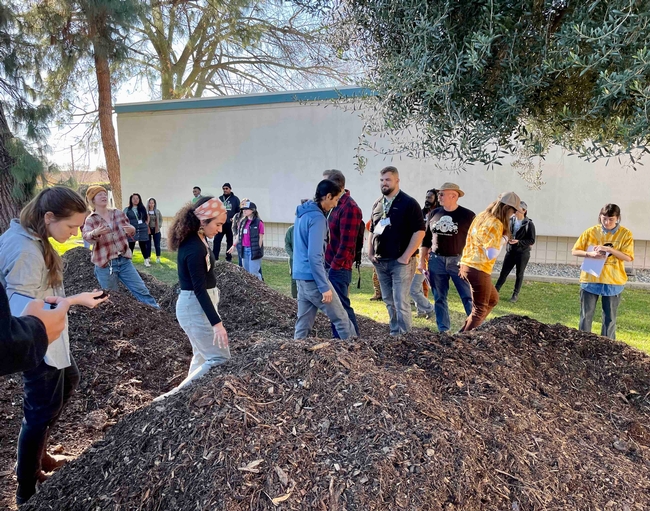
Of the two afternoon composting site tours, I opted for the one that included Temple Beth Israel in Pomona, Claremont Friends Meeting, and the Buddhist Tzu Chi Foundation in San Dimas. Temple Beth Israel was the newest composting site we visited. There are an impressive number of raised beds on the property (around 20 from what I remember), where onions, herbs, greens, and other vegetables are grown in partnership with Uncommon Good. Ten small businesses provide food waste for composting next to the planting beds.
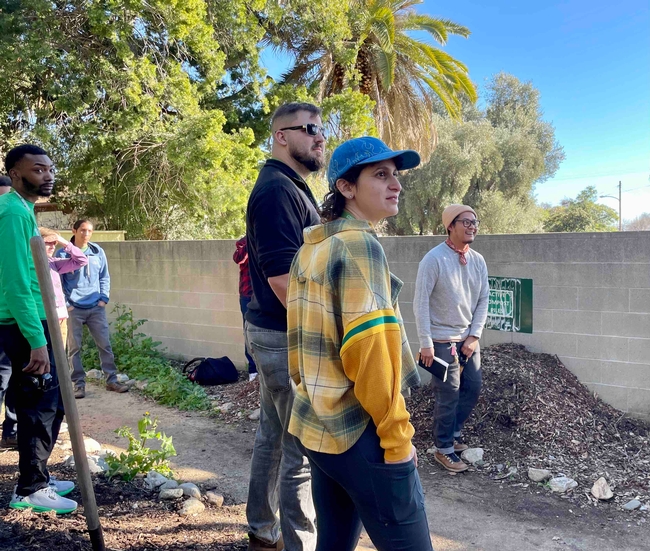
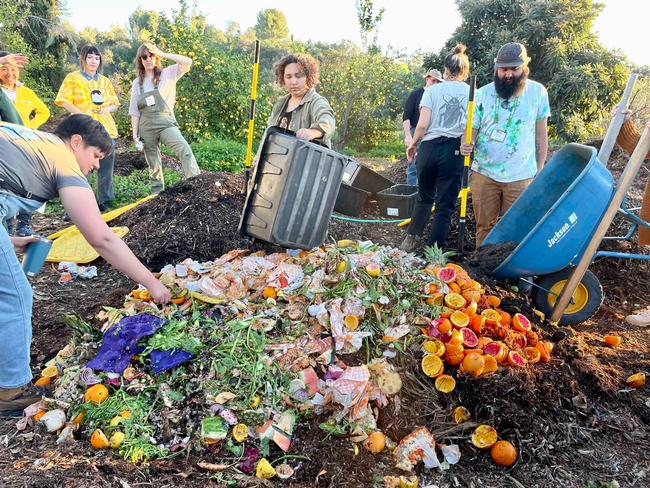
If you want to learn more about composting, check out our UCCE San Bernardino YouTube channel or contact the Master Gardener Helpline at mgsanbern@ucanr.edu or (909) 387-2182.
Have you enjoyed reading this blog? Do you have questions? Need help with school gardens or environmental education? Feel free to contact me at dschnur@ucanr.edu. I look forward to hearing from you.
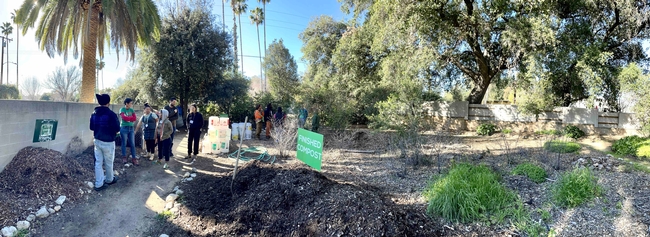
- Author: Margaret J O'Neill
Getting to know your Potting Containers: When a container isn't just a container
When choosing a container for your potted plants there's lots of things to consider. I often find myself making selections based on what I already have in my yard that I can reuse and what will be big enough to for my plant, but there's more to it than that. Container material adds another layer to your yards microclimates and it's something you can use to your advantage to fine tune finding just the right spot/microclimate in your yard. Alternatively, if you are planting in what you have and what you find, (which is what I often do), then knowing the different considerations to make regarding your containers material will help keep your plants happy and healthy.
Brown/Light Colored Plastic:
Benefits: Inexpensive; lightweight; comes in many sizes and shapes; cooler than darker colored pots; usually keeps vertebrate pests out of bottom of pot
Challenges: Cooler than black pots (so that's a benefit, unless you live in a cooler area, or in the winter, and the difference is minimal); not recyclable in most cities, so if they break or when they get old they need to go in the trash if they can't be upcycled for another garden purpose; don't usually provide much insulation or heat protection for new transplants, sensitive plants, or smaller plants
How to use it to increase your microclimates: Overall, great for plants that you might want to move around since they are lightweight; can be reused for many years; great for annual plants that you want to dump and refresh the soil each year/season since they pot itself doesn't add much weight; great for plants that you are worried about getting water logged (as long as they have a drain hole, which is a must!) since the pot itself doesn't retain any water….that also means you need to watch that they don't dry out more often then plants in ground or in other types of pots.
Black/Dark Colored Plastic:
Benefits: Many of the same benefits as above, but can also add that black pots tend to absorb heat and might be good for plants (esp in the cooler seasons) that need a little more warmth, or like warm roots
Challenges: Many of the same drawbacks as the pots above, but will absorb more heat than lighter colored pots so it's important to keep an eye on that during warmer weather
How to use it to increase your microclimates: Again, same benefits as light colored pots, but also can be used to keep plants a little warmer if that is something they benefit from.
Note: The descriptions above fit most pots that you buy plants and trees in at the garden center, but note that those pots are often much thinner than the brown or light colored pots you would buy at the store for planting. The pots' thin plastic doesn't provide much insulation from heat or cold and plants in these pots tend to dry out very quickly. These pots are also not usually recyclable but could be used to start seeds, or could be donated to friends, family, or to a community garden near you that might want to start their own seeds or cuttings.
Wood (sealed gaps/not sealed): If you are thinking about making your own planters, containers, you want to think about the type of wood you are using (treated or not for example) with what type of crops. For ornamental plants that you are not eating it is less crucial that you use untreated wood, but the chemicals in treated wood still might be an area of concern with regards to overall soil contamination (even if it is in small amounts)
Benefits: Nice, natural look; biodegradable; wood absorbs some heat/cool and helps buffer soil temperature; Wood will absorb water and that can help buffer temperature of soil and soil moisture. Some wood pots have their seams and insides sealed and some don't. This will impact how much water is absorbed and how much water leaks out as you water. Note this when getting to know your soil in these types of pots.
Challenges: Often more expensive that plastic pots; can be pretty heavy depending on size and if it's able to absorb water (sealed vs unsealed); biodegradable is also a potential down side, especially if you use it for a perennial plants since pot material will break down over time (some will last for a few seasons, some for many, many years depending on wood type); bottoms will often rot out sooner than sides and burrowing pests like gophers can get into them
How to use it to increase your microclimates: Great foundational pots for your garden if you get bigger ones (like half wine/whisky barrels) or smaller containers can be moved around. Wood can buffer soil temperature and also help keep moisture in. Wooden pots can also absorb water from soil, so whether the pots are sealed or lined will make a difference on that, and you need to get to know how this pot interacts with your soil and plants that you choose for these pots
Glazed ceramic:
Benefits: Nice looking pots that often add color and beauty to the garden! Glazed ceramic pots are one of the more expensive options and if you're on a budget, but would like to incorporate this type of pot into your garden, consider using just a few (or even one) to add a pop of color! Can also buffer soil temperatures in cooler areas or times of year; keeps vertebrate pests out of bottom of pot
Challenges: These pots present lots of challenges in San Bernardino County in warmer weather absorbing a lot of heat during warmer months; don't absorb water because the ceramic is sealed, but that also means that they get water logged more easily; many plants that are more herbaceous/tender that will struggle with the radiating heat off this type of pot; these pots are often heavy compared to unglazed ceramic pots.
How to use it to increase your microclimates: Great for a pop of color for your garden! These pots do well with succulents and other plants that can tolerate the radiating heat in the summer. Plants that are more tolerant (or you are willing to carefully water, checking before watering) of some standing water are good choices for these pots.
Metal containers/beds with bottoms: Note that many metal planter beds and containers are insulated with straw or other material to protect plants from over heating on hot days when the metal gets hot. Any liner or insulation you add will have an impact (sometimes negative, sometimes positive) on water absorption, amount of soil you can add, and more, so it's important to do a little research and be observant, looking for plant health issues, or at how quickly the soil dries out.
Benefits: Vertebrate pests will not be able to get through material to get into container (although they still can go over the sides); depending on any insulation you use this might help with buffering soil temperatures, but if soil is in contact with metal temperatures in the soil will fluctuate with outside hot and cold temperatures
Challenges: Metal will get very hot in the summer (and can get very cold in summer); can be challenging to add more drain holes if needed; can be heavy depending on size
How to use it to increase your microclimates: These containers are often used when gardening on cement or other hard surfaces, or areas where planters may be temporary; also useful in areas with lots of gophers or other burrowing vertebrate pests.
Upcycled containers: these can vary widely depending on what type of material you are using and upcycling
Benefits: great to reuse containers, and can end up with lots of creative “yard art”
Challenges: must keep in mind what type of plants you are planting (edible or not) and what materials the upcycled containers are made of, so that you are not exposing yourself to any undesirable chemicals; when in doubt reach out to our Master Gardeners helpline (By phone:(909)387-2182
By email: mgsanbern@ucanr.edu) to find out more about the type of container you would like to use!
Lastly, it's important to have drain holes in your pots to keep plants from sitting in standing water. You might need to add drain holes or adjust your watering accordingly to keep plants healthy. A variety of pots in your yard are a great way to get benefits from all these different container types or using one type in your yard will help you keep some things in your garden more constant!
- Author: Margaret J O'Neill
Nancy Mannon became a UC Cooperative Extension Master Gardener in San Bernardino County 2019 and her love of gardening and nature was immediately apparent, as you will learn below. She's one of those people, like many of our Master Gardeners, where a plant is not just simply a plant; it is art, it is life, it is habitat, and more. Her husband, Gary, became a MG trainee this spring in our virtual class and was all business and engagement! He has a historical garden that he has been put in charge of and he wanted to make sure he educated himself and got the support to do it right. The Mannons are a great example of the diversity of Master Gardener's passions and interests. They highlight how our Master Gardener program (or the garden in general) is a great place for people with diverse perspectives to come together. It's one of the things that makes this program, and our wonderful volunteers, special, and it's a true joy to be part of it. As for the Mannons, they are wonderful, vital stewards of both the history and future of the city of Upland and it's horticultural heritage, and we are so fortunate to have them as part of our Master Gardener team!
-Maggie O'Neill, UCCE San Bernardino County Master Gardener Coordinator
Why did you decide to be a MG (Master Gardener)?
Gary - I decided to join out of necessity. An organization I am affiliated with put me in charge of a Living
Garden that they own. Partly due to the pandemic, the garden got neglected for a couple of years, and
they wanted me to bring it back to life. I knew nothing about gardening. My wife had previously
graduated from the Master Gardener program. So, she put me in touch with Maggie. I decided to join
the program. The Master Gardeners and Master Food Preservers have been a big help in bringing the
garden back to life. And, I'm learning about gardening.
Nancy - I love plants, nature and love to be outside. When I was a young girl, I went to Butchart Gardens
In Canada. I was amazed at all the wonderful design and color of all the flowers and trees in one huge
garden. I have spent most of my time planting flowers and making the outside look beautiful. I wasn't
sure what I was doing but I just kept on planting whatever my heart called me to plant. Gratefully, my
green thumb paid off. So, when I heard about the MG program, I thought I should jump on board and
see what the real experts have to say about gardening.
What are your gardening passions?
Gary - Currently, it is bringing the garden back to life. I haven't been at it long enough to develop a
passion. I'm still playing catch-up, but I want to add plants to make the garden more attractive to
beneficial insects. Working with good people, towards a common goal, is a definite plus!
Nancy - I think of the ground as like a canvas to an artist. You pick the color, texture, and design, and
watch the garden come to life. Mother nature is amazing with all the vibrant colors and intricate designs
of flowers. Being outside with nature, I would definitely say, it is good for the soul. Also, it's fun to be
surprised by pollinators, like butterflies and hummingbirds flying around your yard.
What do you think gardening gives back to our community and why do you think it's important for
overall community health?
Gary - Growing one's own vegetables, fruit and citrus has a healthier, tastier, more satisfying outcome
than purchasing those products in the store. Locally grown products reduce the transportation and
environmental costs associated with importing from other regions or countries.
Nancy - Every home should have a garden, in a perfect world. Especially, in this day and time. It is
almost a necessity to have your own organic food. We have perfect weather here in southern California
to grow food all year long. With the food situation right now, it is more important than ever to have your own garden or a community garden. There is nothing like eating fresh home grown fruits and
vegetables.
Do you have any tips for the community about conserving water in the drought?
Gary - We took advantage of the turf rebate offered by the city and utility company a couple years ago,
and put in drought-tolerant landscaping. Our water bill was reduced by about half. I water in the early
morning so more water has a chance to seep into the ground instead of evaporate.
Nancy - All plants and trees need water, PERIOD!
What is a tidbit or two you've learned as a MG that the public reading our newsletter could gain from?
Gary - The importance of not ignoring our trees during a drought. People cut back on watering their
landscape, and the trees end up suffering. I see so many dry trees. Sure, you can just replant a tree to
replace the one that died, but it will take many years to regain the canopy of the tree you replaced,
which we all benefit from.
Nancy - Fun fact, dirt is not just dirt, it is soil! A teaspoon of healthy soil contains more bugs than there
are people on earth! Mulch vs. Amendments, and list goes on.
What advice would you give someone considering becoming a UCCE MG?
Gary - I think the class is very interesting. The program is part of the University of California
Agriculture and Natural Resources. All their information is research-based. They teach about
horticulture, plant pathology, dealing with weeds and pests, irrigation, and how to analyze your soil. It's
something every homeowner would benefit from early on, and not wait until you retire, like I did.
Nancy - I tell everyone, the Master Gardener program is fun, interesting, educational, and beneficial. Everyone, can learn something to better this planet, and themselves. In this class you meet like-minded people who care about the environment and Mother Nature.
- Author: Deborah Schnur
For the first time in three years, the California Agriculture in the Classroom Conference was held in-person this past September. Ventura County, with its rich agricultural heritage, was the perfect location for the conference to make its comeback. Growing up on the beaches of Long Island, New York, I was excited to attend the conference and spend some time by the shore. The conference agenda was filled with opportunities to learn and network through tours, presentations, exhibits, workshops, and discussions. Best of all, I returned home with three full bags of materials to use for school and environmental education.
Pre-Conference Tour and Reception

My second favorite part of the tour was walking through Air Force One and seeing how it was used during Reagan's time. The plane was retired after Reagan left office and moved to the site of the Library, where the building was constructed around it. The Air Force One Pavilion also houses vehicles from the presidential motorcade.
After the tour, I returned to the hotel for conference registration and a reception with Maureen McGuire,CEO of the Farm Bureau of Ventura County. I also took some time to network with exhibitors including the California Farm Bureau, California Women for Agriculture,Ventura County Farm to School, Students for Eco-Education and Agriculture (SEEAG), and the Ventura County Agricultural Museum.
Opening Session
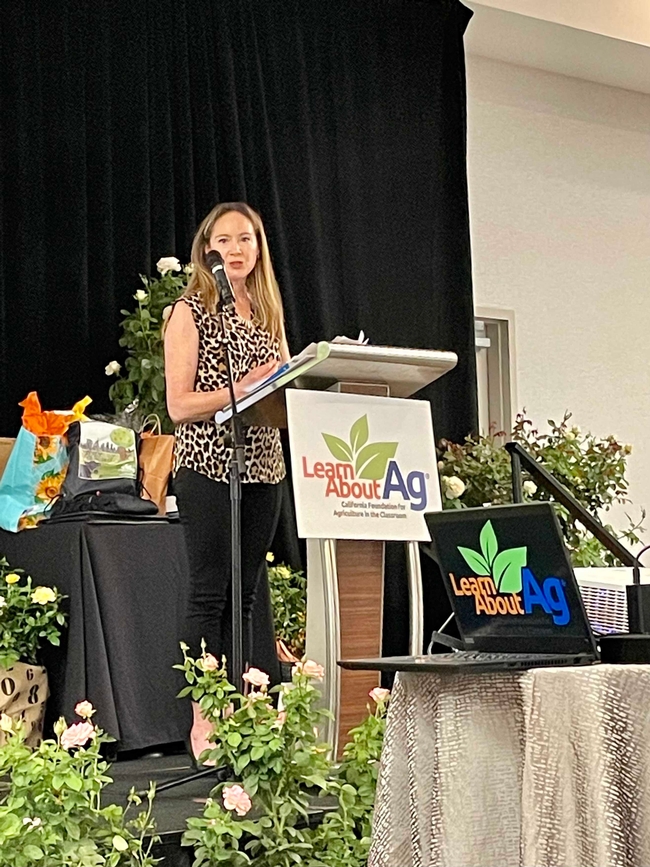
The last speaker was Christine Birdsong, the Undersecretary of the California Department of Food and Agriculture, who emphasized the importance of agricultural literacy for students and teachers. Because California has about 24 million acres of agricultural land and $20 billion in agricultural exports, the state's economic health is closely tied to agriculture. Agriculture is a growing career field that increasingly relies on technology, and a diverse group of young farmers is needed to replace those who are retiring.
Workshops
The opening session was followed by two workshop sessions. The first workshop I attended was “Youth Can Run a School Garden Program”, presented by Abbi Mars of UC CalFresh Healthy Living and students from Arthur Hapgood Elementary in Lompoc. I was inspired to hear how fifth and sixth grade students run all aspects of the school garden and teach younger students about gardening and nutrition. The student leaders rotate through different teams to learn about composting, fruit tree care, hydroponics, harvesting, and teaching. At the end of the workshop, the students gave a demonstration of the “Pest or Pal?” lesson from the CalFresh TWIGS (Teams with Intergenerational Support) curriculum.
My second workshop was “Bringing Gardening into the Classroom”, led by Veronica VanCleave-Hunt of CalFresh Healthy Living. She and her colleague presented three TWIGS garden lessons that can be taught in the classroom without a garden. The first lesson was “Seed Magic” where students dissect a seed and identify the parts. The workshop attendees received lima bean seeds that had been soaked in water and were instructed to remove the seed coat and identify the leaves, root, and cotyledon (food source). Who knew a simple seed could be so interesting?
The second lesson was “Soil” where we used our senses to observe the soil components of sand, silt, and clay. Then we learned how to conduct a soil test by mixing a soil sample with water in a jar and watching the layers separate. The final lesson was “Eat Your Plants” about how food can come from all plant parts: roots, stems, leaves, flowers, fruits, and seeds. The workshop instructors passed around bags, and the attendees tried to identify the fruit or vegetable inside and the plant part.
After the workshops, we were treated to a hearty lunch and an engaging talk from Coach Kiah Twisselman Burchett, “Grow Through It: Blooming Through Hardship”. Coach Kiah is a cattle rancher turned motivational speaker who shares her triumphs and struggles with body image and weight loss to empower others to find joy in life.
Field Trips and Taste of California Dinner
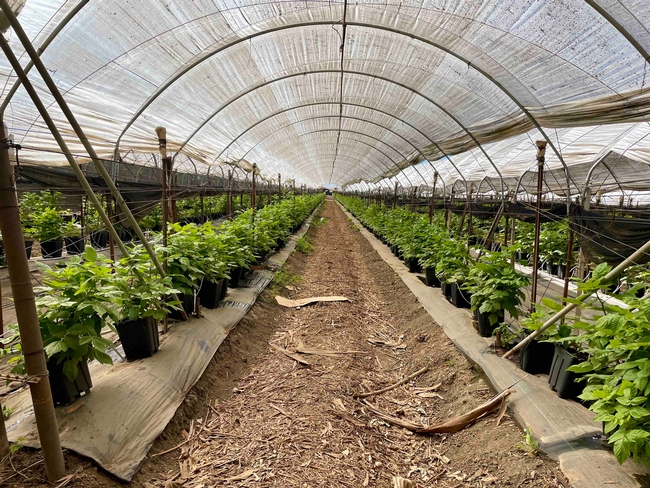
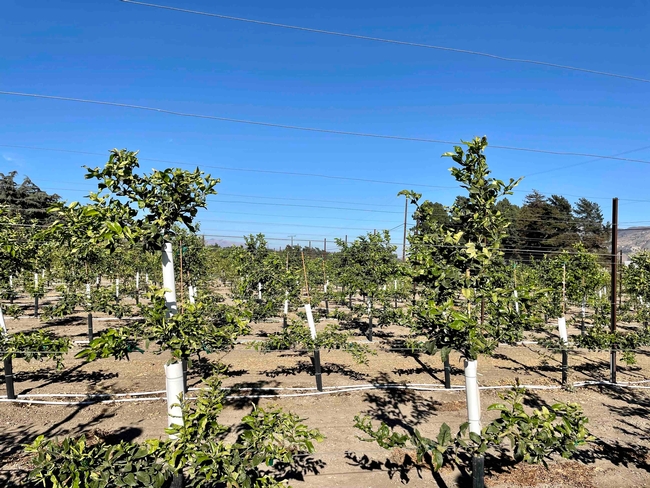
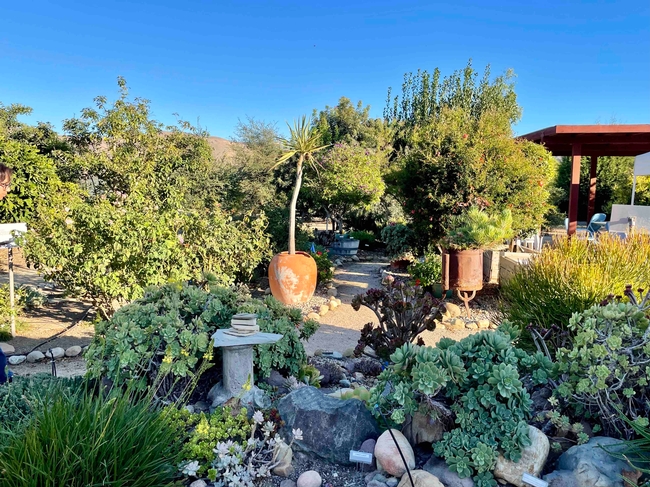
The day ended with the Taste of California at the Ventura County Agriculture Museum in Santa Paula. Each of the 13 tables was decorated according to a theme by a host organization. Hosts ranged from the Santa Paula High School Ag Department to the California Farmland Trust. I opted for the “CA Central Coast Cornucopia of Freshness” table hosted by the California Women for Agriculture, Ventura County. After a welcome from Shannon Douglass of the California Foundation for Agriculture in the Classroom, Coach Kiah took the reins as the emcee for some table games. At the end of the night, I filled a bag with take-home gifts of seeds, citrus, trail mix, and local Blue Ridge honey from my table host.
Closing Sessions

After the panel were the Make ‘n Takes, 20-minute activities to share with students. During the Beads and Books session, I made a daisy beaded bookmark from natural materials. From the Orange You Glad We Have Farmland? session, I learned the percentage of land available to grow food for the world–only 3 percent! The MyPlate Nutrition activity demonstrated ways to introduce the five food groups to students and help them list foods in each group.
I was sad to see the California Ag in the Classroom Conference come to an end but happy to spend a few hours on the beach before heading home. Next year, I look forward to attending the state conference again and maybe even the national conference in Orlando! If you're involved in agriculture education, I highly recommend checking out the resources that Ag in the Clasroom offers at https://learnaboutag.org and https://agclassroom.org.
Have you enjoyed reading this blog? Do you have questions? Need help with school gardens or environmental education? If so, send an email to dschnur@ucanr.edu. I look forward to hearing from you.


